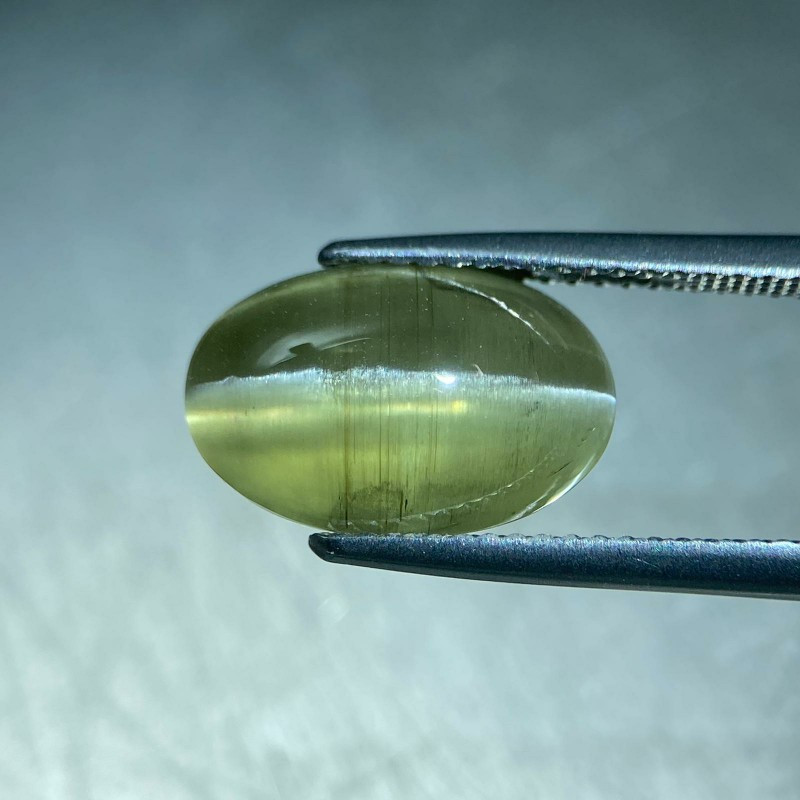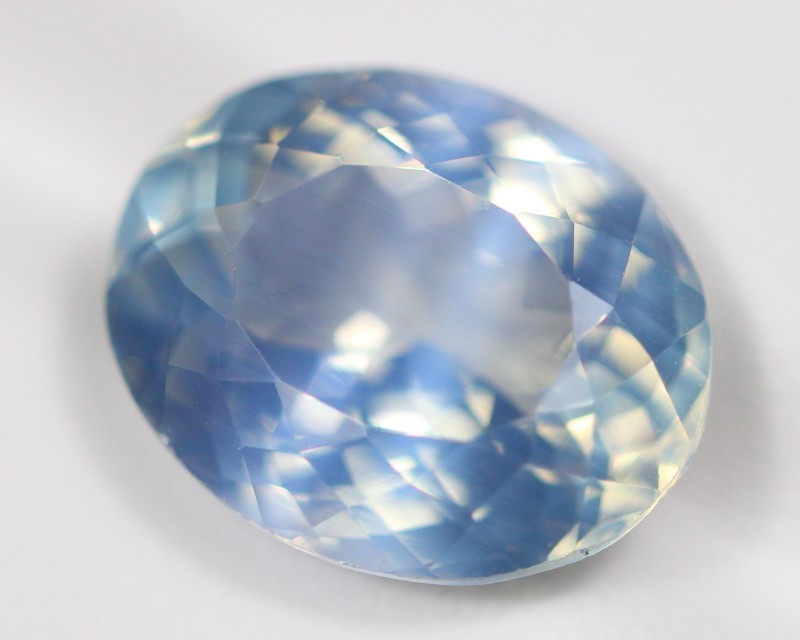
シリマナイト宝石:特性、意味、価格に関する情報
 シリマナイトはアルミノケイ酸塩鉱物で、一般的にはキャッツアイ石とファセットカットされた白、黄、緑の宝石の2つの形で販売されています。どちらの形も様々な色があります。
シリマナイトはアルミノケイ酸塩鉱物で、一般的にはキャッツアイ石とファセットカットされた白、黄、緑の宝石の2つの形で販売されています。どちらの形も様々な色があります。
シリマナイトは美しい一方で、希少でカットが難しいため、コレクターや宝石商の間でよく知られています。このグループの他の鉱物(カイヤナイトやアンダルサイト)と並んで、シリマナイトは最も希少であり、どんなディスプレイにも特別な一品となります。
1977年以降、シリマナイトはアメリカ合衆国デラウェア州の州指定鉱物となっています。希少性が高いにもかかわらず、シリマナイトは非常に耐久性に優れているため、普段使いに最適です。
シリマナイトを購入する前に、このガイドを読んで、シリマナイトの特性、価値要因、価格、意味などをすべて学んでください。

シリマナイト宝石とは何ですか?
シリマナイトはガラス質または絹のような半貴石で、フィブロライト、モンロライト、バムライト、ブコルザイトなど、いくつかの歴史的な名称があります。宝石としての形は美しいものの、その用途の95%は工業用です。
珪線石は何に使われますか?主な工業用途は、ガラスやセラミックなどの耐火材料の製造です。また、金属やセメントの製造、鉄鋼の製錬にも使用されます。
珪線石は歴史を通じて、他の素材を使った道具を作る際にも使用されてきました。珪線石の他の製品や用途には、以下のものがあります。
磁器
工業用強度ガラス
アルミナレンガ
宝石の観点から見ると、シリマナイトは5月の誕生石の代替として用いられます。また、キャッツアイシリマナイトは月の惑星のスターストーンとしても知られています。
シリマナイトの仕様と特徴
シリマナイトの鉱物グループには、 カイヤナイトとアンダルサイトも含まれます。これらはすべて、外観や形成条件が異なるものの、互いに多形(組成は同じだが結晶構造が異なる)です。
この鉱物はアルミノケイ酸塩です。産地によって、珪線石の化学式はAl2SiO5、Al2SiO3、またはAl2(SiO4)Oと表記されます。鉄とチタンは一般的な不純物です。
珪線石(シリマナイト)の原石は、一般的に繊維状と結晶状の2つの形態があります。珪線石は、緻密な塊や繊維状の塊を形成することがあります。結晶は柱状で細長い形状ですが、繊維状のものよりも希少です。
残りのシリマナイトの特性は次のとおりです。
モース硬度:6.5~7.5
色:無色、白、灰色、黄色、茶色、緑、青、青紫
結晶構造:斜方晶系
光沢:ガラス質、亜ガラス質、脂っぽい、または絹のような光沢
透明性:透明から不透明
屈折率:1.65~1.68
密度:3.23~3.27(結晶)、3.14~3.18(緻密体)
谷間:完全、1方向[010]
骨折:不規則/不均一
縞模様:白
発光:ミャンマー産の青い石の蛍光 - SW-UVとLW-UVでは赤色
多色性:シャトヤンシー素材や青や緑の石に時々存在し、強く現れる。シャトヤンシー石:淡黄色、灰褐色、クローブ褐色。青石:無色、青、淡黄色。緑石:濃い緑、黄緑、青。
光学的効果:まれにシャトヤンシー

シリマナイトの種類
シリマナイトの唯一の変種はフィブロライト、またはシリマナイト・キャッツアイです。では、シリマナイト・キャッツアイとは何でしょうか?
フィブロライト(別名キャッツアイシリマナイト、シャトヤントシリマナイト)は、繊維状のシリマナイトの一種で、その名の通り、シャトヤンシー(「キャッツアイ」効果)を示します。これは、平行に並んだ繊維の束が光線を石の中心に反射し、猫の目のように光る現象です。この石は透明から不透明まであります。
シリマナイト・キャッツアイは、ほとんどの場合銀色の反射光を呈しますが、宝石の色はそれぞれ異なります。赤みがかった黒、濃い茶色、灰緑色が最も一般的ですが、以下のような色になることもあります。
赤
黄色
茶色がかったオレンジ
タン
黒
青(濃い、薄い、灰色がかった)
最近、スリランカやミャンマー産の珍しい青紫色の標本が市場に出回っています。

シリマナイト宝石の意味と歴史
シリマナイトは幸福、成功、そして心の平安を象徴します。また、意志の力と知恵を象徴し、特に強いリーダーシップを育む力があると信じられています。
キャッツアイシリマナイトの意味は、前世の探求と予知に関連しています。これらの宝石は、過去、現在、そして未来への旅を象徴しています。歴史的には、身に着ける人を守ると信じられてきました。
歴史
珪線石の最古の証拠は先史時代にまで遡ります。2010年、フランス近海で、軟玉翡翠で作られたものに似た、磨かれた刃物に加工された新石器時代の緻密な珪線石が発見されました。さらに、ネイティブアメリカンは古くから珪線石を使って道具を作ってきました。
シリマナイトの最初の名前は、ファザーカイゼル(ドイツ語で「繊維シリカ」)で、1792年にオーストリアの化学者ジョセフ・リンダッカーがボヘミア(現在のチェコ)で発見された標本に付けました。
1802年、フランスの鉱物学者ジャック・ルイ・ブルノン伯爵は、南インド(カルナータカ州)産の繊維状の珪線石をフィブロライトと名付けました。
シリマナイトに付けられた3番目の名前はブコルツァイトで、ドイツの科学者ルドルフ・ブランデス博士が1819年にこの鉱物について記述したときに選んだものです。この名前はブランデスの指導者であり、有名なドイツの化学者であるクリスチャン・フリードリヒ・ブコルツに敬意を表して付けられました。
ブランデスが記述した標本はチロルアルプス産でした。しかし、その記述は限定的で、わずかに黄色の基調を持つ灰白色の鉱物と説明されていました。
1824年、アメリカの科学者ジョージ・トーマス・ボーエンは、米国コネチカット州で採集された標本を研究し、アメリカの地質学者で化学者のベンジャミン・シリマン・シニアに敬意を表して、シリマナイトに現在の名前をつけました。シリマンは、イェール大学で鉱物学を教えた最初の教授でもありました。
多くの名前と説明があるにもかかわらず、珪線石は広く知られていませんでしたが、1990 年代にインドのオリッサ州で比較的豊富な鉱床が発見されるまではそうでした。

シリマナイトの治癒特性
シリマナイトのような結晶は、 ヒーリングストーンとして特定の力を持つことがあります。ホワイトシリマナイトは、他の白い石と同様に、浄化作用と精神的な覚醒をもたらします。一方、グリーンシリマナイトは、楽観主義や成長といったグリーンの宝石に特有の効能を持っています。
珪線石には他にどのような身体的、感情的な効能があるのでしょうか?
身体の治癒
物理的には、キャッツアイシリマナイトは目に関する問題の治療に役立つと考えられています。シリマナイト自体には、次のような効果があると言われています。
心臓の問題(例:出血、血液循環)
消化器系の問題
肺の問題(例:アレルギー、喘息)
エージング
エンドルフィンの生成
感情的な癒し
前述のエンドルフィンの生成は、シリマナイトが幸福の石として知られていることにも繋がっています。特に、落ち込んだり「マンネリ」を感じている時に、その効果は効果的です。フラストレーションを和らげ、再び自分をワクワクさせるものを見つける手助けをしてくれると言われています。
さらに、シリマナイトの結晶は、意思決定を容易にし、否定的な感情を取り除き、感情を調和させるためによく使用されます。
チャクラヒーリング
チャクラヒーリングは、ブロックされたチャクラ、つまりエネルギーセンターに関連するネガティブな症状を解消することを目的とします。クリスタルは、その色に基づいて特定のチャクラに用いられることがよくあります。
チャクラストーンとして、シリマナイトはどのチャクラ(エネルギーセンター)も開くことができますが、特にハートチャクラのバランスを整え、愛と受容をもたらすのに役立ちます。一方、 黒または茶色のフィブロライトはルートチャクラを開き、安心感と感情的なつながりを取り戻します。
次に、シリマナイトの価値要因について説明しましょう。

シリマナイト宝石の特性
専門家は、色、カット、クラリティ、透明度、カラット重量に基づいて、シリマナイト宝石の客観的な価値を決定します。
色
透明から半透明の珪線石結晶は、無色、白、黄色、緑、青など、様々な色を呈します。フィブロライト(キャッツアイ珪線石)は、灰色、茶色、紫、青、黄色などに加え、前述の「珪線石の種類」のセクションで述べた色調を呈します。
純粋なシリマナイトは無色であるため、他の色合いは通常、不純物や内包物に由来します。青や紫の色合いは、鉄からチタンへの電荷移動によって生じます。黄色や緑の色合いは鉄またはクロムに由来し、茶色も鉄に由来します。
珍しい色合い(青紫、青、無色など)と中程度から高い彩度の石が最も高い価格で取引されます。
カット
多くの宝石はカットするのが難しいのですが、シリマナイトは完璧な劈開性と脆い粘り強さ(結晶の状態)を持つため、ファセット加工が最も難しい宝石の 1 つとなっています。
熟練した宝石研磨師は、オーバルカット、クッションカット、ファンシーファセットカットなど、様々なカットに挑戦します。その結果、希少で価値の高い宝物が生まれます。
緻密なシリマナイトは、多くの場合ファセットカットされていません。キャッツアイ石はカボションカットされますが、その他の素材はビーズや彫刻に加工されることがあります。
明確さと透明性
アンダルサイトは一般的にタイプII のカラーストーンクラリティグレードを有しており、ある程度の目に見える内包物が見られることが想定されます。ほとんどのシリマナイトでは、針状結晶などの内包物は価値を下げます。唯一の例外はキャッツアイシリマナイトです。
キャッツアイシリマナイトは、平行に並んだイルメナイト、ハイパーステン、またはルチルのインクルージョンによってシャトヤンシー(輝き)を呈します。イルメナイトが原因の場合、フィブロライト石は通常黒っぽい色をしています。
シリマナイトの結晶のほとんどは半透明です。透明なシリマナイトは希少であるため、より価値が高くなります。キャッツアイ石のほとんどは不透明であるため、希少な半透明のものもより価値が高くなります。
カラット重量
ファセットカットされたシリマナイトは希少なだけでなく、通常5カラット未満です。キャッツアイは一般的に10カラットに達しますが、最大のものは35カラットにもなります。
サイズは産地によっても異なります。ミャンマーとケニアでは同程度の品質の珪線石が産出されますが、ケニア産の石はわずかに小さめです。

珪線石の形成と産地
カイヤナイトやアンダルサイトと同様に、珪線石は堆積岩の中で熱と圧力による変成作用を受け、二次鉱物として生成されます。これらの条件によって岩石と内部の鉱物の両方が変化し、珪線石のような新しい鉱物が生成されます。
3つの石のうちどれが形成されるかは、熱と圧力のレベルによって決まります。シリマナイトは高温、カイヤナイトは高圧を必要とします。アンダルサイトは低温と低圧で形成されます。
珪線石はどのような種類の岩石に含まれていますか?通常、片岩、片麻岩、花崗岩、アルミニウムを豊富に含む泥質岩などの高変成岩に含まれています。
それを念頭に置いて、珪線石はどこで見つかるのでしょうか?
採掘場所
シリマナイトの最良の産地は、ミャンマー、スリランカ、ケニアです。ミャンマーはキャッツアイシリマナイト(または「ビルマ・フィブロライト」)で知られ、スリランカは灰緑色のキャッツアイシリマナイトを産出します。
スリランカとミャンマーはどちらも、緑、青、または青紫がかった青のファセット加工可能な結晶で有名です。ケニアでは、ミャンマー産の石と同等の品質の淡い青または無色のファセット加工可能な結晶が産出されますが、一般的にサイズはミャンマー産よりも小さいです。
興味深いことに、最大の珪線石結晶のいくつかは南極で発見されました。
その他の珪線石の産地としては以下のようなものがあります:
オーストラリア
オーストリア
ブラジル
カナダ
中国
チェコ
フランス
ドイツ
インド
イタリア
マダガスカル
ノルウェー
スロバキア
南アフリカ
スウェーデン
タンザニア
英国(アイルランドとスコットランド)
アメリカ合衆国(特にデラウェア州、アイダホ州、コネチカット州)
もちろん、どれくらいの価格が期待できるか知りたいですよね?

シリマナイト宝石の価格と価値
シリマナイトは希少であるだけでなく、カットが非常に難しいことでも知られています。ファセットカットやカボションカットされた宝石の価格には、これらの要素が反映されています。しかしながら、シリマナイトは他の人気宝石と比べると、依然として大幅に安価です。
卸売りのファセットカットされたシリマナイト宝石は通常、1カラットあたり18〜95ドルですが、明るい緑色で透明度の高い宝石は1カラットあたり200〜400ドルになることもあります。
キャッツアイカボションのシリマナイトの1カラットあたりの価格は、一般的な濃い色の場合4ドルから11ドルです。白、金褐色、深紅、オレンジといった希少な色の場合は1カラットあたり12ドルから25ドルです。
リングはシリマナイトを使ったジュエリーの中で最も人気があり、特にカボションリングは人気です。価格は、金属のセッティングや組み込まれた他の宝石、そしてアンティークかどうかによって大きく異なります。
ゴールドセッティングのアンティークシリマナイトカボションリングは550ドルから約2,300ドルです。スターリングシルバーセッティングのカボションリングは約40ドルから200ドルです。ファセットカットのシリマナイトリングは通常25ドルから100ドルですが、ゴールドセッティングと大きな宝石が付いたリングは4,000ドルを超えることもあります。
ペンダントは比較的お手頃で、天然のグリーンクリスタルペンダントは約30ドル、その他のスタイルは5ドルから50ドルです。ビーズストランドは8ドルから10ドル、コーティングされたビーズストランドは30ドルから60ドルです。
シリマナイトのケアとメンテナンス
シリマナイトは硬度が高いものの、劈開性と靭性が高いため、破損を防ぐために適切な宝石ケアが不可欠です。カボションカットはより耐久性に優れていますが、ファセットカットされたシリマナイトのジュエリーには保護セッティングが必要です。
スポーツ、ガーデニング、掃除など、激しい運動をする際は石の着用を避けてください。また、刺激の強い化学薬品にも近づけないでください。
代わりに、石鹸水と柔らかいマイクロファイバークロスで拭いて清潔に保ち、すすいでください。その後、布張りのジュエリーボックスやポーチに入れて、他の宝石とは分けて保管してください。

シリマナイトに注目していますか?
ファセットカットされたシリマナイト宝石に見られる典型的な黄色の色合いは、この石が幸福感を高め、未来に目を向けさせる「気分を良くする」クリスタルであるという評判を反映しています。
しかし、シリマナイトのスタイルは無限大。アースカラーのボヘミアンスタイルにも、洗練されたコスモポリタンスタイルにもぴったりの石が見つかります。しかも、あまり知られていないので、周りの人から一際目立つ可能性も高いでしょう!
Gemstone Encyclopedia検索
最新記事
レインボーラティスサンストーンは、様々な内包物によって3つのゴージャスな光学的効果を持つ長石の一種です。燃えるように鮮やかな色合いと格子模様が、コレクターにとって希少な宝石となっています。
12th Jan 2026
チューライトは、ゾイサイト鉱物ファミリーに属する、鮮やかなバラ色の色合いを示す希少なノルウェー産の宝石で、ジュエリーのセッティングやペンダントによく使用されます。
6th Jan 2026
記事のカテゴリ
How To's is where you will find helpful articles from gem Rock Auctions on how to cut gemstones, select gemstones and buy gemstones.
9記事数

